Black Watch
The Black Watch, 3rd Battalion, Royal Regiment of Scotland (3 SCOTS) is an infantry battalion of the Royal Regiment of Scotland. The regiment was created as part of the Childers Reforms in 1881, when the 42nd (Royal Highland) Regiment of Foot (The Black Watch) was amalgamated with the 73rd (Perthshire) Regiment of Foot. It was known as The Black Watch (Royal Highlanders) from 1881 to 1931 and The Black Watch (Royal Highland Regiment) from 1931 to 2006. Part of the Scottish Division for administrative purposes from 1967, it was the senior Highland regiment. It has been part of the Scottish, Welsh and Irish Division for administrative purposes from 2017.
| The Black Watch, 3rd Battalion, Royal Regiment of Scotland (3 SCOTS) | |
|---|---|
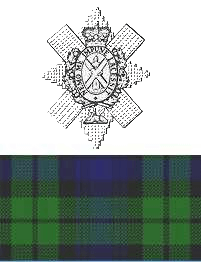 Former cap badge and tartan | |
| Founded | 1 July 1881 |
| Country | |
| Branch | |
| Type | Line infantry |
| Role | Light infantry |
| Size | One battalion |
| Part of | 51st Infantry Brigade and Headquarters Scotland |
| Garrison/HQ | Fort George, Inverness |
| Nickname(s) | "The Forty Twa"[1] "Black Jocks" (slang term used by members of other regiments) "Ladies from Hell" |
| Motto(s) | (Scotland's) Nemo me impune lacessit Latin: "No One Provokes Me with Impunity" |
| March | Quick: "All the Blue Bonnets Are O'er the Border" Slow: "The Garb of Old Gaul" Pipes & Drums Quick: "Hielan' Laddie" Pipes & Drums Slow: "My Home" Pipes & Drums Slow: "Highland Cradle Song" |
| Anniversaries | Red Hackle Day (5 January) |
| Battle honours | see below |
| Commanders | |
| Royal Colonel | HRH The Duke of Rothesay |
| Insignia | |
| Tactical Recognition Flash |  |
| Hackle | Red |
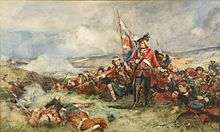

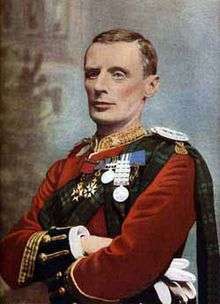
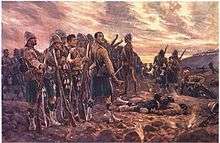

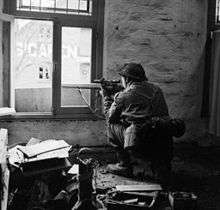
Source of the name
The source of the regiment's name is uncertain. In 1725, following the Jacobite rebellion of 1715, General George Wade was authorised by George I to form six "watch" companies to patrol the Highlands of Scotland, three from Clan Campbell, one from Clan Fraser of Lovat, one from Clan Munro and one from Clan Grant. These were to be "employed in disarming the Highlanders, preventing depredations, bringing criminals to justice, and hindering rebels and attainted persons from inhabiting that part of the kingdom." The force was known in Gaelic as Am Freiceadan Dubh, "the dark" or "black watch".[2]
This epithet may have come from the uniform plaids of dark tartan with which the companies were provided. Other theories have been put forward; for instance, that the name referred to the "black hearts" of the pro-government militia who had sided with the "enemies of true Highland spirit",[3] or that it came from their original duty in policing the Highlands, namely preventing "blackmail" (Highlanders demanding extortion payments to spare cattle herds).[4]
History
The regiment was created as part of the Childers Reforms in 1881, when the 42nd (Royal Highland) Regiment of Foot (The Black Watch) was amalgamated with the 73rd (Perthshire) Regiment of Foot to form two battalions of the newly named Black Watch (Royal Highlanders). The 42nd became the 1st Battalion, and the 73rd became the 2nd Battalion.[5]
The 1st Battalion saw action at the Battle of Tel el-Kebir in September 1882 during the Anglo-Egyptian War. It was in combat again during the Mahdist War, at the First and Second Battles of El Teb in February 1884, the Battle of Tamai in March 1884 and at the Battle of Kirbekan in February 1885.[5] They were stationed in India from 1896, but was sent to South Africa for service during the Second Boer War. After the war ended in June 1902 with the Peace of Vereeniging, 630 officers and men left Cape Town on the SS Michigan in late September 1902, arriving at Southampton in late October, when they were posted to Edinburgh.[6]
The 2nd Battalion was posted to South Africa in October 1899, following the outbreak of the Second Boer War. The battalion suffered heavy losses at the Battle of Magersfontein in December 1899.[7] After the end of the war, about 730 officers and men left Point Natal for British India on the SS Ionian in October 1902, where after arrival in Bombay it was stationed in Sialkot in Umballa in Punjab.[8]
In 1908, the Volunteers and Militia were reorganised nationally, with the former becoming the Territorial Force and the latter the Special Reserve;[9] the regiment now had one Reserve and five Territorial battalions.[10][11]
First World War
Regular Army
The 1st Battalion landed at Le Havre as part of the 1st Brigade in the 1st Division in August 1914 for service on the Western Front.[12] It saw action during the Retreat from Mons in August 1914, the First Battle of the Marne in September 1914 and the First Battle of the Aisne later in September 1914; it also took part in the advance to the Hindenburg Line in September 1918.[13]
The 2nd Battalion landed at Marseille as part of the Bareilly Brigade in the 7th (Meerut) Division in October 1914 for service on the Western Front.[12] It took part in the defence of Givenchy in December 1915[13] and then moved to Mesopotamia later that month and saw action during the siege of Kut in Spring 1916, the fall of Baghdad in March 1917 and the Battle of Istabulat in April 1917.[13] It transferred to Palestine in January 1918 and took part in the Battle of Megiddo in September 1918.[13]
Territorial Force
The 1/4th (City of Dundee) Battalion landed at Le Havre as part of the Bareilly Brigade in the 7th (Meerut) Division March 1915 for service on the Western Front and, following heavy losses at the Battle of Neuve Chapelle in March 1915 and the Battle of Festubert in May 1915,[13] amalgamated with 2nd Battalion in September 1915.[12] The 1/5th (Angus and Dundee) Battalion landed at Le Havre as part of the 24th Brigade in the 8th Division for service on the Western Front.[12] It also saw action at the Battle of Neuve Chapelle in March 1915 and the Battle of Festubert in May 1915.[13] The 1/6th (Perthshire) Battalion and the 1/7th (Fife) Battalion landed at Boulogne-sur-Mer as part of the 153rd Brigade in the 51st (Highland) Division in May 1915 for service on the Western Front.[12] They saw action at the Battle of the Ancre Heights in October 1916.[13]
New Armies
The 9th (Service) Battalion landed at Boulogne-sur-Mer as part of the 44th Brigade in the 15th (Scottish) Division in July 1915 for service on the Western Front.[12] It suffered over 700 wounded or killed-in-action at the Battle of Loos in September 1915 and then suffered heavy losses again at the Second Battle of the Somme in August 1918.[13] The 10th (Service) Battalion landed at Boulogne-sur-Mer as part of the 77th Brigade in the 26th Division in September 1915 for service on the Western Front.[12] It moved to Salonika in November 1915 and took part in operations in the Balkans in 1916.[13]
A number of authors state that the regiment was given the nickname "Ladies from Hell" ("Die Damen aus der Hölle") by German troops, allegedly on account of their kilts and fighting qualities.[14][15]
Second World War
Regular Army
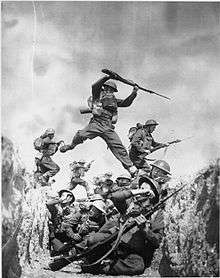

The 1st Battalion landed in France in September 1939 as part of the 12th Brigade in the 4th Infantry Division for service with the British Expeditionary Force (BEF). The battalion later transferred to the 153rd Brigade of the 51st (Highland) Division and was captured at St Valery-en-Caux during the Battle of France. It was reformed from reserve units of the 9th (Highland) Infantry Division in August 1940 and moved to North Africa in August 1942 where it fought at the Second Battle of El Alamein in October 1942 and then continued to fight in the Tunisian Campaign before it took part in the Allied invasion of Sicily in July 1943. It also took part in the Normandy landings in June 1944, the Battle for Caen later that month and the Battle of the Falaise Pocket in August 1944. It later saw action at the Battle of the Bulge in January 1945, Battle of the Reichswald in February 1945 and the crossing of the Rhine in March 1945.[16]
The 2nd Battalion was serving in Palestine from where it was sent to East Africa in August 1940 and saw action during the Italian conquest of British Somaliland. It was sent to Crete, as part of the 14th Brigade in the 8th Division, and took part in the Battle of Heraklion in May 1941. It moved to North Africa in October 1941 and took part in the break out from Tobruk in November 1941.[16]
Territorial Army
The 4th Battalion landed in France in January 1940 as part of the 153rd Brigade in the 51st (Highland) Division for service with the BEF and then took part in the Dunkirk evacuation in June 1940. From July 1940 to April 1943 the battalion was stationed in Gibraltar.[16] The battalion remained in the United Kingdom for the rest of the war.[16]
The 5th Battalion landed in North Africa as part of the 153rd Brigade in the 51st (Highland) Division and fought at the Second Battle of El Alamein in October 1942. It also took part in the Normandy landings, while attached to the 3rd Parachute Brigade, in June 1944 and saw action at the Battle for Caen followed by the Battle of Bréville later that month. It saw combat again at the Battle of the Falaise Pocket in August 1944 and the Battle of the Bulge in January 1945.[16]
The 6th Battalion landed in France in January 1940 as part of the 154th Brigade in the 51st (Highland) Division for service with the BEF. The battalion exchanged places with the 1st Battalion and became part of the 12th Brigade of the 4th Division and then took part in the Dunkirk evacuation in June 1940. It moved to North Africa in the spring of 1943 for service in the final stages of the Tunisian Campaign and then on to the Italian Front in February 1944 where it took part in the Battle of Monte Cassino in the spring of 1944.[16] The battalion later fought on the Gothic Line before being sent to Greece in late 1944, where it remained for the rest of the war.[16]
The 7th Battalion landed in North Africa as part of the 154th Brigade in the 51st (Highland) Division and fought at the Second Battle of El Alamein in October 1942. It also took part in the Normandy landings in June 1944, the Battle for Caen later that month and the Battle of the Falaise Pocket in August 1944. It later saw action at the Battle of the Bulge in January 1945. The 7th Battalion was also one of the first battalions to cross the river Rhine during Operation Plunder on the 23 March 1945.[16]
After the War
Late 1940s
The 2nd Battalion was deployed to India in 1945 and arrived at Cherat Cantonment, thirty-four miles from Peshawar, on 15 August 1947, when India and Pakistan became independent.[17] On 26 February 1948 the battalion became the last British Army unit to leave Pakistan, boarding a transport ship at Karachi, after a formal parade through the streets with the salute taken by the Prime Minister Jinnah.[18][19][20]
1950s to 1970s
The regiment won honours after the Second Battle of the Hook in November 1952 during the Korean War.[21] The regiment helped to suppress the Mau Mau Uprising in Kenya in 1953 and to suppress the actions of EOKA during intercommunal violence in Cyprus in the late 1950s.[22]
During the state funeral of John F. Kennedy in November 1963, nine bagpipers from the regiment were invited to travel to the United States and participate in the funeral procession from the White House to the Cathedral of St. Matthew the Apostle. They performed The Brown Haired Maiden, The Badge of Scotland, The 51st Highland Division, and The Barren Rocks of Aden.[23] The Black Watch had won such renown that in December 1964 during an Anglo-American summit, President Lyndon Johnson asked the British Prime Minister Harold Wilson to send the Black Watch to Vietnam, a request that was refused.[24]
The Black Watch served in Northern Ireland during the Troubles as part of Operation Banner. The regiment was frequently a major target of the Provisional Irish Republican Army (PIRA) and the Irish National Liberation Army (INLA). A lance corporal serving with the regiment was shot by a sniper in East Belfast in November 1971 and a young private serving with the regiment was killed while on foot patrol in Dungannon, County Tyrone, by a remote control device in July 1978.[25]
Hong Kong Handover Ceremony
The Black Watch was the last British military unit to leave Hong Kong in 1997, and it played a prominent role in the handover ceremony.[21]
2000s
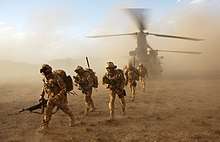
During the 2003 Iraq War, the Black Watch fought during Operation Telic in the initial attack on Basra, and during its deployment, the unit suffered a single fatality.[26] The following year, the Black Watch was dispatched to Iraq again, as part of 4 (Armoured) Brigade. On 12 August, a soldier from the regiment was killed as a result of an improvised explosive device (IED).[27] In October, the Black Watch was at the centre of political controversy after the United States Army requested British forces to be moved further north, outside of the British-controlled Multi-National Division (South East), to replace forces temporarily redeployed for the Second Battle of Fallujah. Despite objections in Parliament, the deployment went ahead. Based at Camp Dogwood, located between Fallujah and Karbala, in an area later dubbed the "Triangle of Death", the Black Watch came under sustained insurgent attack from mortars and rockets. On 29 October, during the journey to their new base, a Black Watch soldier was killed in a road accident.[28] On 4 November, three soldiers and an interpreter were killed by a car bomb at a check point,[29] and on 8 November, another soldier was killed: the high-profile nature of the deployment caused a magnification of these events back home in Britain.[30]
Under a plan devised by Lieutenant General Alistair Irwin and approved by General Sir Mike Jackson, on 16 December 2004, it was announced that the Black Watch was to join with five other Scottish regiments – the Royal Scots, the King's Own Scottish Borderers, the Royal Highland Fusiliers, The Highlanders and the Argyll and Sutherland Highlanders – to form the Royal Regiment of Scotland, a single regiment consisting of five regular and two territorial battalions. The measure, which reflected recruiting difficulties and the inefficiencies inherent in maintaining a number of relatively small separate units, took place on 28 March 2006.[31]
In July 2007 the battalion moved from Palace Barracks in Belfast to Fort George.[32]
On 24 June 2009, it was reported that elements of the battalion numbering about 350 troops carried out one of the largest air assault operations of the NATO troops in Afghanistan, named Operation Panther's Claw,[33] by deploying into and attacking a Taliban stronghold located near Bābājī (باباجی ), north of Lashkar Gah.[34] The operation commenced on 19 June just before midnight.[33] After a number of combat engagements with the insurgents, the soldiers of the battalion secured three main crossing points: the Lui Mandey Wadi crossing, the Nahr-e-Burgha canal and the Shamalan canal.[35] Lieutenant Colonel Stephen Cartwright, Commanding Officer of The Black Watch battalion, was reported saying that this operation established a firm foothold in what was the last remaining Taliban area controlled in the southern Helmand Province.[36] The location of the Taliban force in the area had allowed it to conduct attacks on the A01 highway, a major national route connecting Kandahar and Herat. During 22 June, troops of the battalion also "found 1.3 tonnes of poppy seed and a number of improvised explosive devices and anti-personnel mines before they could be laid."[33] Analysis by the United Nations Food and Agriculture Organisation revealed the haul to be of mung beans, not poppy seed.[37]
Following the Army 2020 Refine, the battalion will remain at Fort George until 2023 when it will move to another barracks in Scotland. Following the refine, the battalion was equipped with the Foxhound light mechanised vehicle. The battalion was also moved under the command of the 51st Infantry Brigade and Headquarters Scotland.[38][39]
Regimental museum
The Battalion Headquarters and regimental museum are located at Balhousie Castle in Perth.[40]
Uniform and traditions
The Black Watch's primary recruiting areas are in Fife, Dundee, Angus and Perth and Kinross. The battalion is permitted to retain its most famous distinction, the red hackle on the Tam o'Shanter.[41]
Notable members
The following are notable individuals who served with the regiment:
- Alfred Anderson, Scotland's last surviving World War I veteran (d. 2005)
- Bernard Fergusson, Baron Ballantrae, the last British-born Governor-General of New Zealand
- Jim Baxter, Scottish footballer
- Fergus Bowes-Lyon, older brother of Queen Elizabeth The Queen Mother
- Duncan Campbell, Scots nobleman and British Army officer
- Iain Cuthbertson, actor
- Harold Davis, Scottish former professional football player
- Henry Davie, Liberal Member of Parliament for Haddington
- Adam Ferguson, Scottish philosopher, social scientist and historian
- Al Foreman, British lightweight boxing champion, assigned as a non-combat drummer boy at the end of WWI at age 14, very brief service. Later received Distinguished Flying Cross with Royal Air Force in WWII.
- Stewart Granger, actor
- J. B. S. Haldane, British-born geneticist and evolutionary biologist
- Karl Leyser, German-born medieval historian and Oxford professor
- Christopher Logue, English poet
- Fulton Mackay, Scottish actor
- Gillean Maclaine, the 25th hereditary Chief of Clan Maclaine of Lochbuie
- Lachlan Macquarie, Governor of New South Wales, Australia from 1810 to 1821
- Robert Munro, the original Black Watch commander, Colonel Sir Robert Munro
- John Murray, theologian
- Brian Nelson, Northern Irish loyalist
- Eric Newby, English travel author
- Simon Ramsay, Conservative politician and colonial governor
- Neil Ritchie, British Army officer during the Second World War
- William Rose, screenwriter
- Bertie Snowball, golfer
- Rory Stewart, Scottish diplomat, Harvard professor and Conservative MP
- Frederick Tait, Scottish soldier and amateur golfer
- Peter Walls Lt General of Rhodesia Army
- Arthur Wauchope, British soldier and colonial administrator
- Archibald Wavell, British field marshal during the Second World War
Recipients of the Victoria Cross
The following Black Watch servicemen were awarded the Victoria Cross:[42]
- Francis Farquharson, Indian Mutiny Lucknow, 9 March 1858
- John Simpson, Indian Mutiny Fort Ruhya, 15 April 1858
- Alexander Thompson, Indian Mutiny Fort Ruhya, 15 April 1858
- James Davis, Indian Mutiny Fort Ruhya, 15 April 1858
- Edward Spence, Indian Mutiny Fort Ruhya, 15 April 1858
- William Gardner, Indian Mutiny Bareilly, 5 May 1858
- Walter Cook, Indian Mutiny Sissaya Ghat, 15 January 1859
- Duncan Millar, Indian Mutiny Sissaya Ghat, 15 January 1859
- Samuel McGaw, Ashanti War Amoaful, 31 January 1874
- Thomas Edwards, Egyptian Campaigns Tamaai, 13 March 1884
- John Ripley, First World War Rue du Bois, 9 May 1915
- David Finlay, First World War Rue du Bois, 9 May 1915
- Charles Melvin, First World War Istabulat, 21 April 1917
- Lewis Evans, First World War Zonnebeke, 4 October 1917
- Bill Speakman, Korean War, 4 November 1951
Battle honours
- The battle honours consist of the combined battle honours of the 42nd Regiment and the 73rd Regiment, together with:[11]
- Guadaloupe 17591, Martinique 17621, Havannah1, North America 1763–64, Mysore5, Busaco³, Salamanca4, South Africa 1846–476, 1851-2-36 Tel-el-Kebir, Egypt 1882 '84, Kirbekan, Nile 1884–85, Paardeberg, South Africa 1899–1902
- The Great War [25 battalions]: Retreat from Mons, Marne 1914 '18, Aisne 1914, La Bassée 1914, Ypres 1914 '17 '18, Langemarck 1914, Gheluvelt, Nonne Bosschen, Givenchy 1914, Neuve Chapelle, Aubers, Festubert 1915, Loos, Somme 1916 '18, Albert 1916, Bazentin, Delville Wood, Pozières, Flers-Courcelette, Morval, Thiepval, Le Transloy, Ancre Heights, Ancre 1916, Arras 1917 '18, Vimy 1917, Scarpe 1917 '18, Arleux, Pilckem, Menin Road, Polygon Wood, Poelcappelle, Passchendaele, Cambrai 1917 '18, St Quentin, Bapaume 1918, Rosières, Lys, Estaires, Messines 1918, Hazebrouck, Kemmel, Béthune, Scherpenberg, Soissonnais-Ourcq, Tardenois, Drocourt-Quéant, Hindenburg Line, Épéhy, St Quentin Canal, Beaurevoir, Courtrai, Selle, Sambre, France and Flanders 1914–18, Doiran 1917, Macedonia 1915–18, Egypt 1916, Gaza, Jerusalem, Tell'Asur, Megiddo, Sharon, Damascus, Palestine 1917–18, Tigris 1916, Kut al Amara 1917, Baghdad, Mesopotamia 1915–17
- The Second World War: Defence of Arras, Ypres-Comines Canal, Dunkirk 1940, Somme 1940, St. Valery-en-Caux, Saar, Breville, Odon, Fontenay le Pesnil, Defence of Rauray, Caen, Falaise, Falaise Road, La Vie Crossing, Le Havre, Lower Maas, Venlo Pocket, Ourthe, Rhineland, Reichswald, Goch, Rhine, North-West Europe 1940 '44–45, Barkasan, British Somaliland 1940, Tobruk 1941, Tobruk Sortie, El Alamein, Advance on Tripoli, Medenine, Zemlet el Lebene, Mareth, Akarit, Wadi Akarit East, Djebel Roumana, Medjez Plain, Si Mediene, Tunis, North Africa 1941–43, Landing in Sicily, Vizzini, Sferro, Gerbini, Adrano, Sferro Hills, Sicily 1943, Cassino II, Liri Valley, Advance to Florence, Monte Scalari, Casa Fortis, Rimini Line, Casa Fabbri Ridge, Savio Bridgehead, Italy 1944–45, Athens, Greece 1944–45, Crete, Heraklion, Middle East 1941, Chindits 1944, Burma 1944
- The Hook 1952, Korea 1952–53; Al Basrah, Iraq 2003; Second Battle of Fallujah, Iraq 2004
1. awarded 1909 for services of 42nd Regiment.
2. awarded 1914 for services of 42nd Regiment.
3. awarded 1910 for service of 42nd Regiment.
4. awarded 1951 for service of 42nd Regiment.
5. awarded 1889 for service of 73rd Regiment.
6. awarded 1882 for service of 73rd Regiment.
Colonels-in-Chief
Regimental Colonels
Colonels of the regiment were:[11]
- The Black Watch (Royal Highlanders)
- 1881–1888 (1st Battalion): Gen. Sir Duncan Alexander Cameron, GCB (ex 42nd Foot)
- 1881–1885 (2nd Battalion): Gen. Sir Henry Robert Ferguson-Davie, Bt. (ex 73rd Foot)
- 1888–1907 (1st Battalion): Gen. Sir Robert Rollo, KCB
- 1907–1914: Lt-Gen. Sir John Chetham McLeod, GCB
- 1914–1929: Gen. Sir John Grenfell Maxwell, GCB, KCMG, CVO, DSO
- 1929–1940: Gen. Sir Archibald Rice Cameron, GBE, KCB, CMG
- The Black Watch (Royal Highland Regiment) (1935)
- 1940–1946: Gen. Sir Arthur Grenfell Wauchope, GCB, GCMG, CIE, DSO
- 1946–1950: F.M. Sir Archibald Wavell, 1st Earl Wavell, GCB, GCSI, GCIE, CMG, MC
- 1950–1952: Gen. Sir Neil Methuen Ritchie, GBE, KCB, DSO, MC
- 1952–1960: Maj-Gen. Neil McMicking, CB, CBE, DSO, MC
- 1960–1964: Maj-Gen. Robert Keith Arbuthnott, 15th Viscount of Arbuthnott, CB, CBE, DSO, MC
- 1964–1969: Brig. Henry Conyers Baker-Baker, DSO, MBE
- 1969–1976: Brig. Rt. Hon. Bernard Edward Fergusson, Baron Ballantrae, KT, GCMG, GCVO, DSO, OBE
- 1976–1981: Brig. John Cassels Montieth, CBE, MC, JP
- 1981–1992: Maj-Gen. Andrew Linton Watson, CB
- 1992–2003: Brig. Garry Charles Barnett, OBE, ADC
- 2003–2006: Lt-Gen. Sir Alistair Stuart Hastings Irwin, KCB, CBE
- 2006: Regiment amagalmated with the Royal Scots, the King's Own Scottish Borderers, the Royal Highland Fusiliers, The Highlanders (Seaforth, Gordons and Camerons) and the Argyll and Sutherland Highlanders – to form the Royal Regiment of Scotland
Alliances
The battalion has the following alliances:[11]
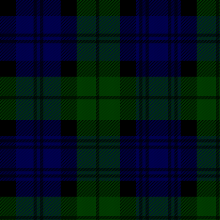
.svg.png)
.svg.png)
.svg.png)
.svg.png)
.svg.png)


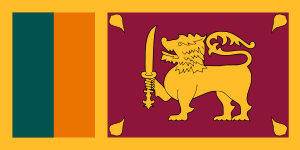

Before and after the Second World War, the Australian Militia, later renamed the Citizen Military Forces (CMF), included the 30th Battalion, New South Wales Scottish Regiment. This unit was affiliated with the Black Watch.[43]
Canada (from 1862) has its own Black Watch, being raised as the 5th Battalion of the Canadian Militia, being renamed by 1914 as the 5th Regiment (Royal Highlanders of Canada).[44] It adopted its current title, The Black Watch (Royal Highland Regiment) of Canada, prior to the Second World War, and saw action in both world wars.[45]
Anecdotes
When wearing the kilt, it is customary for troops to "go regimental" or "military practice", wearing no underwear.[46][47] In 1997, a Black Watch soldier received wide press exposure because of windy conditions during a military ceremony in Hong Kong.[46]
In popular culture
- Anthems associated with the regiment include "Wha Saw the Forty-Second", ("Wha saw the Forty Twa") a reworking of the Jacobite song "Wha Wadna Fecht For Charlie",[48] "The Gallant Forty Twa", and "Twa Recruiting Sergeants".[49]
- In 2006, the National Theatre of Scotland premiered a new play, Black Watch, by Gregory Burke at the Edinburgh Festival Fringe. Compiled from interviews with former soldiers, the play dealt with the history of the regiment and in particular the recent deployment in Iraq.[50]
- The regiment are lambasted in an Irish rebel song The Black Watch, recorded by various artists such as the Irish Brigade, the Fighting Men of Crossmaglen, Athenry and Shebeen, for their role in the Troubles. The lyrics speak of the Black Watch, "strolling down the Falls Road with riot guns and gas, terrorising women as they're coming out of Mass."[51]
Gallery
- 'Glasgow Green, c.1758'. A painting in the regimental museum showing a review of Black Watch recruits, c.1758'.
- Detail from the painting 'Glasgow Green, c.1758'.
- Detail from the painting 'Glasgow Green, c.1758'.
 The Black Watch on Parade at Gibraltar.
The Black Watch on Parade at Gibraltar. Black Watch soldiers pass by a burning German anti-aircraft half-track, Sicily, 5 August 1943.
Black Watch soldiers pass by a burning German anti-aircraft half-track, Sicily, 5 August 1943. Black Watch Memorial, Aberfeldy.
Black Watch Memorial, Aberfeldy. Black Watch South African Wars Memorial, Edinburgh.
Black Watch South African Wars Memorial, Edinburgh.
 3 details from the Black Watch Memorial, Edinburgh.
3 details from the Black Watch Memorial, Edinburgh.
 Black Watch Memorial on Powrie Brae near Dundee
Black Watch Memorial on Powrie Brae near Dundee
See also
References
- From the regimental number – 42
- Simpson, p. 114–115
- Parker, p. 13–14
- Trevor-Roper, p. 205
- "Empire: 1815–1915". The Black Watch. Retrieved 8 May 2016.
- "The Army in South Africa - Troops returning Home". The Times (36888). London. 2 October 1902. p. 4.
- "Black Watch". Anglo-Boer War. Retrieved 8 May 2016.
- "The Army in South Africa - Troops returning Home". The Times (36893). London. 8 October 1902. p. 8.
- "Territorial and Reserve Forces Act 1907". Hansard. 31 March 1908. Retrieved 20 June 2017.
- These were the 3rd Battalion (Special Reserve), with the 4th (City of Dundee) Battalion at Parker Street in Dundee (since demolished), the 5th (Angus and Dundee) Battalion at Bank Street in Brechin, the 6th (Perthshire) Battalion at Tay Street in Perth (since demolished), the 7th (Fife) Battalion at Market Street / City Road in St Andrews (since demolished) and the 8th (Cyclist) Battalion at Perth Road in Birnam (all Territorial Force)
- "The Black Watch (Royal Highland Regiment)". Regiments.org. Archived from the original on 30 December 2005. Retrieved 15 May 2016.
- "The Black Watch". The Long, Long Trail. Retrieved 8 May 2016.
- "First World War". The Black Watch. Archived from the original on 2 July 2016. Retrieved 8 May 2016.
- Robert Douglas Pinkerton (1918), Ladies from Hell, New York: The Century Co., p. 76, OCLC 1907457,
It was perhaps seven or eight hundred yards from our trenches to the German line, nearly half a mile, and over this space went the Ladies from Hell, as the Germans call the Scottishers.
- Riguidel, Lt., Donna (7 July 2010). Queens' Own Camerons History Made With History Book Presentation. National Defence and the Canadian Forces. Department of National Defence (Canada).
"Ladies from Hell" was a nickname given to kilted regiments during the First World War, by the Germans that faced them in the trenches (Die Damen aus der Hölle).
- "Second World War". The Black Watch. Retrieved 8 May 2016.
- "Peshawar Remembered". Khyberlodge.co.uk. 30 April 2004. Retrieved 15 May 2018.
- "Last British troops leave Pakistan (1947)". YouTube. 15 August 1947. Retrieved 15 May 2018.
- "Post War | 1945-2006". The Blackwatch. 19 November 1952. Retrieved 15 May 2018.
- Royle, Trevor (2006). The Black Watch: A Concise History. Mainstream. ISBN 978-1845960896.
- "Black Watch Colours are consigned to history". The Independent. 23 June 2012. Retrieved 8 May 2016.
- "1945-2006". The Black Watch. Retrieved 8 May 2016.
- "Funeral Music". John F. Kennedy Presidential Library & Museum. Retrieved 1 August 2013.
- Prenderghast, Gerald Britain and the Wars in Vietnam: The Supply of Troops, Arms and Intelligence, 1945-1975 Jefferson: McFarland, 2015 page 109
- "Black Watch". Palace Barracks Memorial Garden. Retrieved 8 May 2016.
- "Lance Corporal Barry Stephen". Ministry of Defence. 24 March 2003. Retrieved 8 May 2016.
- "Private Marc Ferns". Ministry of Defence. 14 August 2004. Retrieved 8 May 2016.
- "Private Kevin McHale". Ministry of Defence. 1 November 2004. Retrieved 8 May 2016.
- "3 British soldiers killed in Iraq". Ministry of Defence. 6 November 2004. Retrieved 8 May 2016.
- "Private Pita Tukutukuwaqa". Ministry of Defence. 10 November 2004. Retrieved 8 May 2016.
- "Black Watch". British Army units 1945 on. Retrieved 8 May 2016.
- "The Royal Regiment of Scotland". British Army units 1945 on. Retrieved 8 May 2016.
- "3 SCOTS launch massive air assault, UK MOD". Mod.uk. Archived from the original on 7 May 2010. Retrieved 6 June 2011.
- Maddux, Catherine (23 June 2009). "NATO Troops Stage Air Assault on Taliban Stronghold in Southern Afghanistan". VOA News. Archived from the original on 25 June 2009. Retrieved 8 May 2016.
- "UK Troops In Huge Air Assault On Taliban". SkyNews. 2009. Archived from the original on 24 June 2009. Retrieved 8 May 2016.
- "British Forces Target Taliban Stronghold". Afghan Mania. 2010. Retrieved 8 May 2016.
- Boone, Jon (30 June 2009). "Opium crop haul just a hill of beans, admits MoD". guardian.co.uk. Retrieved 4 July 2009.
- "Royal Regiment of Scotland". www.army.mod.uk. Retrieved 9 October 2019.
- "British Army units from 1945 on - Royal Regiment of Scotland". british-army-units1945on.co.uk. Retrieved 9 October 2019.
- "Castle and museum". The Black Watch. Retrieved 8 May 2016.
- "Tam o'Shanter with hackle". The Black Watch. Retrieved 8 May 2016.
- "Victoria Cross Recipients". The Black Watch. Archived from the original on 17 March 2013. Retrieved 8 May 2016.
- "30th Australian Infantry Battalion". Australian War Memorial. Retrieved 8 May 2016.
- Copp, p. 11
- "Black watch Canada". Retrieved 8 May 2016.
- "When a blue moon has more to do with the wind-chill factor". The Sunday Herald. 14 January 2001. Archived from the original on 5 November 2013. Retrieved 8 May 2016.
- "Scots tradition hit by cover-up ruling". The Times. 2 August 2004. Retrieved 12 May 2008.
- "Wha Saw the 42nd". Digital Tradition Mirror. Retrieved 8 May 2016.
- "Twa Recruitin' Sergeants". Henry's Song Book. Retrieved 8 May 2016.
- "Black Watch – Edinburgh Festival Fringe 2006". National Theatre of Scotland. 2006. Retrieved 1 August 2013.
- "The Black WATCH". Irish Folk Songs. 2017. Retrieved 26 May 2017.
Sources
- Copp, Terry (2007). The Brigade: The Fifth Canadian Infantry Brigade in World War II. Stackpole Books. ISBN 978-0-8117-3422-6.
- Parker, John (2008). Black Watch. Headline Book Publishing. ISBN 978-0-7553-1348-8.
- Simpson, Peter (1996). The Independent Highland Companies, 1603–1760. Edinburgh: John Donald. ISBN 0-85976-432-X.
- Trevor-Roper, Hugh (2009). The Invention of Scotland. Yale University Press. ISBN 978-0-300-13686-9.
Further reading
- Anton, James (2007). Royal Highlander : a soldier of H. M. 42nd (Royal) Highlanders during the Peninsular, South of France and Waterloo Campaigns of the Napoleonic Wars. [U.K.]: Leonaur Ltd. ISBN 978-1-84677-223-8.
- Durie, William (2012). The British Garrison Berlin 1945–1994 : a pictorial historiography of the British occupation. Berlin: Vergangenheitsverl. ISBN 978-3-86408-068-5.
- Grant, Charles; Youens, Michael (15 June 1971). The Black Watch. Osprey Publishing. ISBN 978-0-85045-053-8.
- Grant, James (1 January 1999). The Black Watch or, Forty-Second Highlanders. Elibron.com. ISBN 978-1-4021-7481-0.
- Schofield, Victoria (26 April 2012). The Highland Furies: The Black Watch 1739–1899. Quercus Publishing. ISBN 978-1-84916-918-9.
External links
| Wikimedia Commons has media related to Black Watch. |
- 3 SCOTS on British Army website
- The Black Watch Website
- Black Watch Canada
- Archive catalogues for collections relating to soldiers of the 73rd Regiment and 42nd Regiment (The Black Watch), The Black Watch Castle & Museum, Perth, Scotland.